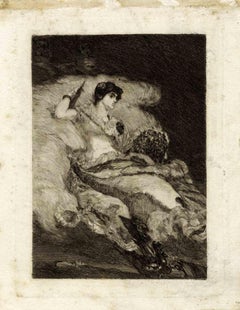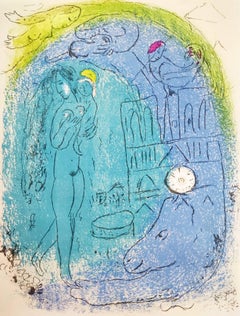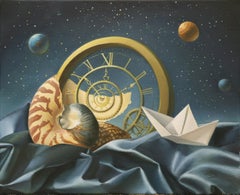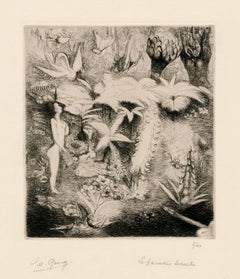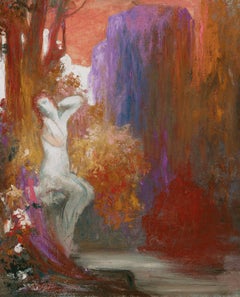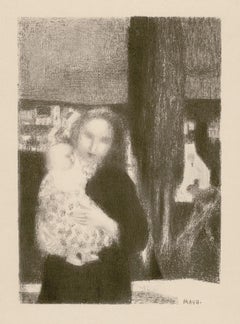Symbolist Art
to
105
573
103
158
44
74
Overall Width
to
Overall Height
to
2
108
641
204
27
103
111
93
13
12
24
18
49
15
114,341
65,173
55,054
27,072
14,917
9,399
6,543
5,789
4,193
3,054
2,579
2,333
2,238
717
604
265
65
567
356
234
182
181
109
101
58
48
48
46
39
33
31
26
25
20
20
20
19
258
224
161
159
134
96
44
38
37
34
132
434
549
247
Style: Symbolist
Die Balldame - Etching by Max Klinger - 1884
By Max Klinger
Located in Roma, IT
Rare etching realized by Max Klinger in 1884.
II state on 2.
Image dimensions: 13.9x19 cm.
Very good condition except for some diffused foxing in the margins.
Ref. Singer, 284.
Category
1880s Symbolist Art
Materials
Etching
Mother and Child Before Notre-Dame
By Marc Chagall
Located in OPOLE, PL
Marc Chagall (1887-1985) - Mother and Child Before Notre-Dame
Lithograph from 1952.
Dimensions of work: 35 x 26 cm
Publisher: Tériade, Paris.
On the verso another Lithograph in b...
Category
1950s Symbolist Art
Materials
Lithograph
"The Tides", Blue and Gold Symbolist Original Oil Painting
By Andrée Bars
Located in Clermont-Ferrand, Auvergne-Rhône-Alpes
"The Tides", is a symbolist oil painting on canvas by Andrée Bars.
In this composition at once cosmic and contemplative, the artist explores the invisible motion that connects time...
Category
2010s Symbolist Art
Materials
Oil
'Le Paradis Terrestre' (Paradise on Earth) — French Symbolism
Located in Myrtle Beach, SC
Edouard Goerg, 'Le Paradis Terrestre' (Paradise on Earth), etching, 1931, edition 40. Signed, titled, and numbered '3/40' in pencil. A fine richly-inked impression, on heavy, cream w...
Category
1930s Symbolist Art
Materials
Etching
Ondine
By Pierre Marcel-Béronneau
Located in New Orleans, LA
Mystical and mysterious, a mythological Ondine rests beside an ethereal forest pond in this majestic, original oil on canvas by French Symbolist Pierre-Amédée Marcel-Béronneau. A stu...
Category
20th Century Symbolist Art
Materials
Canvas, Oil
Untitled (Mother and Child)
Located in Myrtle Beach, SC
Maurice Denis, Untitled (Mother and Child), lithograph, 1897, edition not stated. Signed in the stone, lower right. Annotated in linotype 'MAURICE DENIS, ORIGINAL LITHOGRAPHIE PAN III' in the lower left sheet corner. A fine, atmospheric impression, in warm, dark gray ink, on buff wove paper, with full margins (2 1/2 to 1 3/4 inches); a small discoloration in the bottom left sheet corner, otherwise in good condition. Image size 8 5/8 x 6 7/8 inches; sheet size 13 7/8 x 10 5/8 inches. As published in 'Pan', the leading German magazine of the period devoted to art and literature. Matted to museum standards, unframed.
Collection: Los Angeles County Museum of Art.
Reproduced: German Expressionist Prints...
Category
1890s Symbolist Art
Materials
Lithograph
VEITH E. Young girl with rose tree. Oil on cardboard. Signed and situated 'Wien'
By Eduard Veith
Located in Paris, FR
Young girl with rose tree. Oil on cardboard. Signed and situated 'Wien'
Eduard Veith, son of the room painter Julius Veith (1820-1887) and his w...
Category
Early 20th Century Symbolist Art
Materials
Oil
Love, Death and the Beyond - Etching by Max Klinger - 1881
By Max Klinger
Located in Roma, IT
Love, Death and the Beyond is a original modern artwork realized by Max Klinger in 1881.
The artwork belongs to a series of prints called Intermezzi realized by Max Klinger, publish...
Category
1880s Symbolist Art
Materials
Etching
Chez les Passants - Rare Book Illustrated by Félicien Rops - 1890
Located in Roma, IT
Chez les Passants is an original Rare Book written by Philippe-Auguste, comte de Villiers de l'Isle-Adam (7 November 1838 – 19 August 1889) and illustrated by Félicien Rops (Namur, 7 luglio 1833 – Essonnes, 23 agosto 1898) in 1890.
Original First Edition.
Published by Comptoir d’édition, Paris.
Format: in 12°. The dimensions and the weight are indicative.
The book includes 320 pages with full page frontispiece etching.
Good conditions.
Félicien Victor Joseph Rops (7 July 1833 – 23 August 1898) was a Belgian artist associated with Symbolism and the Parisian Fin-de Siecle. He was a painter, illustrator, caricaturist and a prolific and innovative print maker, particularly in intaglio (etching and aquatint). Although not well known to the general public, Rops was greatly respected by his peers and actively pursued and celebrated as an illustrator by the publishers, authors, and poets of his time and provided frontispieces and illustrations for Jules Barbey d'Aurevilly, Charles Baudelaire, Charles De Coster...
Category
1890s Symbolist Art
Materials
Paper, Etching
Seascape : As Light as a Feather - Original Oil on Canvas, Handsigned
Located in Paris, IDF
Bernard LOUEDIN
Seascape : As Light as a Feather, 1978
Original Oil on Canvas
Handsigned and dated in the lower left corner
On canvas 46 x 61 cm (c. 1...
Category
Late 20th Century Symbolist Art
Materials
Canvas, Oil
Nostalgia. 1995. Paper, etching, 41x36 cm
Located in Riga, LV
Nele Zirnite (1959)
2003 Associate Professor, Art Department, the Latvian Christian Academy
2000 M.F.A., the Latvian Art Academy
1995 – 2003 Lecturer, Graphic Arts Department...
Category
1990s Symbolist Art
Materials
Paper, Etching
"Harlequin and his dog", 20th Century oil on cardbard by Ismael de la Serna
Located in Madrid, ES
ISMAEL GONZÁLEZ DE LA SERNA
Spanish, 1898 - 1968
HARLEQUIN AND HIS DOG
Signed and dated I. de la Serna, 1955
Oil on cardboard
42 X 27-1/2 i...
Category
1950s Symbolist Art
Materials
Oil, Cardboard
Menashe Kadishman, Sheep head 37, Acrylic on canvas
Located in Tel Aviv, IL
Menashe Kadishman, Sheep head, Symbolist painting, colored painting, Israeli art, Israeli art
Category
1980s Symbolist Art
Materials
Acrylic
Dinner 1988, paper, etching, 9x14 cm
Located in Riga, LV
Nele Zirnite (1959)
2003 Associate Professor, Art Department, the Latvian Christian Academy
2000 M.F.A., the Latvian Art Academy
1995 – 2003 Lecturer, Graphic Arts Department...
Category
2010s Symbolist Art
Materials
Paper, Etching
Painting 20th Century Symbolism Esotericism
By Numa François Gillet
Located in Saint-Ouen, FR
GILLET Numa François (1868- 1940)
Oil on wood panel signed low left
Dedicated and dated 1933
Old Antique frame gilded with gold leaves
Dim panel : 37 X 55 cm
Dim frame : 61 X 78 cm
GILLET Numa François (1868- 1940)
French 19th-20th century
Painter, ceramist, architect designer
Symbolist movement
Numa François Gillet...
Category
Early 20th Century Symbolist Art
Materials
Oil
Simplicius' Writing Lesson from Intermezzi - Etching by Max Klinger - 1881
By Max Klinger
Located in Roma, IT
Simplicius' Writing Lesson (Simplici Schreibstunde) (plate VII) belongs to a series of prints called Intermezzi realized by Max Klinger, published by Nurnberg: Stroefer, 1881.
Etchi...
Category
1880s Symbolist Art
Materials
Etching
The Creator Serpent - Aboriginal Dot Painting in Acrylic on Canvas
Located in Soquel, CA
The Serpent - Aboriginal Dot Painting in Acrylic on Canvas
Bold dot painting with a snake by Aboriginal Australian artist Geoffrey "Pirup" Woods (Abor...
Category
Late 20th Century Symbolist Art
Materials
Canvas, Acrylic, Stretcher Bars
"Eve and the apple" by Vivaldo Martini - Oil on canvas 65x50 cm
Located in Geneva, CH
His first name sounds like a concerto. Vivacious, its name is reminiscent of an aperitif or a cyclist. The addition of the two evokes the Italianate. Indomitable and unavoidable. Mor...
Category
Mid-20th Century Symbolist Art
Materials
Canvas, Oil
Evening in the Mountains by Joseph André Mussler - Oil on Wood - 45x45 cm
Located in Geneva, CH
Joseph André Mussler (1904-1980) was a Swiss painter known for his works depicting natural landscapes, often focusing on scenes from the Alps, such as mountain valleys and alpine hut...
Category
Mid-20th Century Symbolist Art
Materials
Oil, Wood
L'agonie - Etching by Félicien Rops - 1896
Located in Roma, IT
L’agonie is an original colored etching on paper realized by Félicien Rops in 1886, 3rd state of colours proof n°8, from Pellet éditeur, inscribed in p...
Category
1890s Symbolist Art
Materials
Etching
Father and son oil on canvas painting surrealist
Located in Sitges, Barcelona
Ramón Llovet (1917-1987) - Father and son - Oil on canvas
Canvas measures 50x61 cm.
Frame measures 56x67 cm.
Ramon Llovet Miserol (Barcelona, August 7, 1917 - Barcelona, August ...
Category
1960s Symbolist Art
Materials
Canvas, Oil
Menashe Kadishman, Sheep head with crown, Acrylic on canvas
Located in Tel Aviv, IL
Menashe Kadishman, Sheep head, Symbolist painting, colored painting, Israeli art, Israeli art
Category
1980s Symbolist Art
Materials
Acrylic
Night Dream : the Swanns - Original Lithograph, 1898
Located in Paris, IDF
Francis JOURDAIN
Night Dream : the Swanns, 1898
Original lithograph (Champenois workshop)
Printed signature in the plate
On vellum, 40 x 31 cm (c. 16 x 12 in)
INFORMATION: Lithogra...
Category
1890s Symbolist Art
Materials
Lithograph
Flores bajo el cielo - Óleo sobre tela - Año 1941
Located in Sant Celoni, ES
La obra va firmada por el artista en la parte inferior y fechada del año 1941
Se presenta enmarcada la pintura (el marco presenta algunas leves faltas)
El estado de la obra es buen...
Category
1940s Symbolist Art
Materials
Oil
Das Grausen - Lithograph After A. Kubin - 1903
By After Alfred Kubin
Located in Roma, IT
Das Grausen is a lithograph realized after a work by Alfred Kubin in 1903, Hand-signed and titled, plate from Faksimiledrucke nach Kunstblättern, edition H. Von Weber.
Included a...
Category
Early 1900s Symbolist Art
Materials
Lithograph
Illustration from the Series "Les Fleurs du Mal" after Odilon Redon - 1923
By Odilon Redon
Located in Roma, IT
Illustration from the series "Les Fleurs du Mal" is an etching print realized after Odilon Redon and published by Henri Felury in 1923.
Monogrammed on the plate.
Good conditions.
...
Category
1920s Symbolist Art
Materials
Lithograph
Landslide from Intermezzi - Etching by Max Klinger - 1881
By Max Klinger
Located in Roma, IT
Landslide from Intermezzi belongs to a series of prints called Intermezzi realized by Max Klinger, published by Nurnberg: Stroefer, 1881.
Etching on paper.
Signed on the plate
Goo...
Category
1880s Symbolist Art
Materials
Etching
$835 Sale Price
30% Off
Der Philosoph - Etching by Max Klinger - 1885
By Max Klinger
Located in Roma, IT
Image dimension cm 29.7x19.9.
Printed in the lower margin, center: «Max Klinger / Der Philisoph / (Aus «Vom Tode, II») / Pan I 2».
Engraving from the art periodical Pan, vol. I, no...
Category
1880s Symbolist Art
Materials
Etching
Amor, Tod und Jenseits - Etching by M. Klinger - 1881
By Max Klinger
Located in Roma, IT
Amor, Tod und Jenseits, (Cupid, death and afterlife) is an original etching and aquatint on paper Chine collé, realized by Max Klinger in 1881, plate XII from “Intermezzi” Opus IV,...
Category
1880s Symbolist Art
Materials
Etching, Aquatint
Ex Libris - Memento Vivere - Woodcut by Michel Fingesten - 1930s
Located in Roma, IT
Ex Libris - Memento Vivere is a colored woodcut print created by Michel Fingesten.
Hand Signed on the lower right margin.
Good conditions.
Michel Fingesten (1884 - 1943) was a ...
Category
1930s Symbolist Art
Materials
Woodcut
Sogno di Oro (Golden Dream) - Symbolist Figurative Painting in Blue and Gold
Located in New York, NY
Gregory Kitterle's Sogno di Oro (Golden Dream) is a 39 x 50 inch horizontal figurative symbolist painting on canvas. This work brings the viewer in a magical setting of lapis lazuli ...
Category
2010s Symbolist Art
Materials
Oil, Canvas
Ex Libris de Francisco Camp Rodon Valer - Woodcut Print - Mid-20th Century
Located in Roma, IT
Ex Libris de Francisco Camp Rodon Valer is an Artwork, woodcut print on ivory-colored paper. The work is glued on cardboard.
Total dimensions: 20.5 x 15 cm.
The artwork represents...
Category
1950s Symbolist Art
Materials
Woodcut
"Each Has Its Destiny", Snails in Nature Symboliste Oil Painting
By Andrée Bars
Located in Clermont-Ferrand, Auvergne-Rhône-Alpes
Titled "Each Has Its Destiny," this charming symbolist oil painting on canvas by Andrée Bars offers a serene and contemplative view of nature's delicate balance. The composition features three snails navigating their way across a barbed wire fence, set against a backdrop of a lush meadow under a clear blue sky.
The snails, each with distinctively colored shells – one brown, one dark, and one golden – symbolize individuality and the unique paths each creature takes in life. The barbed wire, often associated with barriers and challenges, contrasts with the gentle and slow movement of the snails, suggesting a journey filled with obstacles yet approached with patience and determination.
The bamboo stalks and various wildflowers in the background add a touch of whimsy and natural beauty, emphasizing the coexistence of fragility and resilience in the natural world. The delicate rendering of the leaves and flowers, along with the meticulous depiction of the snails, showcases the artist's attention to detail and mastery of texture.
The painting's soft lighting and subtle color palette evoke a sense of calm and introspection, inviting the viewer to reflect on the theme of destiny and the slow but steady progress each individual makes despite life's challenges. "Each Has Its Destiny" is a poignant reminder of perseverance and the unique journey every being undertakes, rendered with elegance and sensitivity.
Andrée Bars is a French painter. Having been strictly trained for 4 years by the American hyper-realist painter Mr. Ted Seth Jacobs, who himself inherited 19th century masters’ skills from his own professor, Andrée Bars learned the profession of painting in its purest tradition. She still applies these ancient masters...
Category
2010s Symbolist Art
Materials
Oil
Victory - Bronze Sculpture After A. Wildt - 1990
By Adolfo Wildt
Located in Roma, IT
Second Edition of 6 copies plus 3 Artist’s Proofs, realized in 1990 after the famous homonymous sculpture realized by Wildt in 1918/19. Authorized by Wildt's heirs, from the original...
Category
1990s Symbolist Art
Materials
Bronze
Pursued Centaur (Verfolgter Centaur) - Etching by Max Klinger - 1881
By Max Klinger
Located in Roma, IT
Pursued Centaur (Verfolgter Centaur) belongs to a series of prints called Intermezzi realized by Max Klinger, published by Nurnberg: Stroefer, 1881.
Etching on paper.
Signed on the...
Category
1880s Symbolist Art
Materials
Etching
$1,003 Sale Price
30% Off
Ex Libris - Leicht - Etching by Michel Fingesten - 1930s
Located in Roma, IT
"Ex Libris - Leicht" is an etching on ivory-colorated paper by Michel Fingesten, Early 20th Century. Hand signed in pencil.
In excellent conditions: As good as new.
Michel Finges...
Category
1930s Symbolist Art
Materials
Etching
Flood
Located in Kansas City, MO
Stella Jae
Flood
2023
Archival Pigment Print on Hahnemuehle Baryta Rag 315gsm
Size: 24.01 x 18.11 inches (61 x 46cm)
Edition: 15
Signed, titled and dated on...
Category
2010s Symbolist Art
Materials
Rag Paper, Archival Pigment
ROGANEAU Early 20th century Symbolist painting French Wolves Acropolis Athens
Located in PARIS, FR
François Maurice ROGANEAU
Bordeaux, 1883 - Aix-en-Provence, 1973
Oil on canvas on cardboard
44 x 32 cm (55 x 44 cm with frame)
Signed lower left “FMR”
Mount Lycabettus opposite to t...
Category
Late 19th Century Symbolist Art
Materials
Oil
Nude, Eleganza by Robert Elibekyan
Located in La Canada Flintridge, CA
The artwork size is 7"x5", oil on canvas board. The frame is included.
Category
Early 2000s Symbolist Art
Materials
Oil
"The Graces Lie Shy" Intaglio Etching
Located in Soquel, CA
"The Graces Lie Shy" intaglio etching by Chaim Koppelman (American b.1920 d.2009).
Moody etching by prominent American printmaker and educator Chaim Koppelman. In this piece a nude...
Category
1950s Symbolist Art
Materials
Paper, Etching, Intaglio
Brahms-Phantasie - Rare Portfolio of 41 Engravings by Max Klinger - 1894
By Max Klinger
Located in Roma, IT
Brahms-Phantasie is a wonderful in-folio volume: the Brahm's Phantasies musical score is incredibly illustrated with 37 numbered plates for a total of 41 original engravings (burin, ...
Category
1890s Symbolist Art
Materials
Paper, Engraving
Kraft und Mut (Courage and Strength), German antique engraving
Located in Melbourne, Victoria
'Kraft und Mut'
(Courage and Strength)
German wood-engraving, 1903.
320mm by 230mm (image)
280mm by 410mm (sheet)
Category
Early 20th Century Symbolist Art
Materials
Engraving
Weddigen - Vintage Héliogravure by Franz von Bayros - Early 20th Century
Located in Roma, IT
"Weddigen" is an original Black and white héliogravure on cream-colored cardboard realized by Choisy Le Conin, pseudonym of Franz Von Bayros (Agram, 1866 – Vienna, 1924).
From Mappe...
Category
Early 20th Century Symbolist Art
Materials
Engraving
"Love" Copper Plate Heliogravure
Located in Palm Beach, FL
2018 marks the centenary anniversary of Ferdinand Hodler’s death. In that 100 years time, the art world’s esteem of this important artist has proved fickle. It has shifted from extolling his artistic merits during his lifetime to showing something of a feigned disdain- more reflective of the world political order than a true change of heart for Hodler’s work. After years of Hodler being all but a footnote in the annals of art history and generally ignored, finally, the pendulum has righted itself once again. Recent retrospective exhibitions in Europe and the United States have indicated not only a joyful rediscovery of Hodler’s art but a firm conviction that his work and world view hold particular relevance today. DAS WERK FERDINAND HODLERS is not only a collection of printed work reflecting the best of all of his painted work created up to 1914 just before the outbreak of World War I, the portfolio itself is an encapsulation of Hodler’s ethos, Parallelisme.
Hodler developed his philosophy of Parallelisme as a unifying approach to art which strips away detail in search of harmony. By means of abstraction, symmetry and repetition, Hodler sought ways to depict Nature’s essence and her fundamental, universal order. He believed these universal laws governing the natural, observable world extend to the spiritual realm. Symbolist in nature with Romantic undertones, his works are equally portraits of these universal concepts and feelings governing all life as they are a visual portrait in the formal sense. Whether his subject is a solitary tree, a moment in battle, mortal fear, despair, the awe inspired by a vast mountain range, a tender moment or even the collective conviction in a belief, Hodler unveils this guiding principle of Parallelisme.
Several aspects of Hodler’s portfolio reinforce his tenets of Parallelisme. The Table of Contents clearly preferences a harmonious design over detail. The two columns, consisting of twenty lines each, list the images by order of appearance using their German titles. The abbreviated titles are somewhat cryptic in that they obscure the identities of the sitters. Like the image Hodler presents, they are distillations of the sitter without any extraneous details. This shortening was also done in an effort to maintain a harmonious symmetry of the Table of Contents, themselves, and keep titles to a one-line limit. The twenty-fourth title: “Bildnis des Schweizerischen Gesandten C.” was so long, even with abbreviation, that it required two lines; so, for the sake of maintaining symmetry, the fortieth title: “Bauernmadchen” was omitted from the list. This explains why the images are not numbered. Hodler’s reasoning is not purely esoteric. Symmetry and pattern reach beyond mere formal design principles. Finding sameness and imposing it over disorder goes to the root of Hodler’s identity and his art. A Swiss native, Hodler was bi-lingual and spoke German and French. Each printed image, even number forty, have titles in both of Hodler’s languages. Certainly, there was a market for Hodler’s work among francophones and this inclusion may have been a polite gesture to that end; however, this is the only place in the portfolio which includes French. With German titles at the lower left of each image, Hodler’s name at bottom center and corresponding French titles at the lower right of each image, there is a harmony and symmetry woven into all aspects of the portfolio. This holds true for the page design, as it applies to each printed image and as it describes the Swiss artist himself. Seen in this light, Hodler’s portfolio of printed work is the epitome of Hodler’s Parallelisme. DAS WERK FERDINAND HODLERS is also one of the most significant documents to best tell the story of how Hodler, from Switzerland, became caught between political cross-hairs and how the changing tides of nations directly impacted the artist during his lifetime as well as the accessibility of his art for generations to come.
The Munich-based publisher of the portfolio, R. Piper & Co., Verlag, plays a crucial role in this story. Publishing on a wide range of subjects from philosophy and world religion to music, literature and the visual arts; the publisher’s breadth of inquiry within any one genre was equal in scope. Their marketing strategy to publish multiple works on Hodler offers great insight as to what a hot commodity Hodler was at that time. R.Piper & Co.’s Almanach, which they published in 1914 in commemoration of their first ten years in business, clearly illustrates the rapid succession- strategically calculated for achieving the deepest and broadest impact - in which they released three works on Hodler to hit the market by the close of 1914. DAS WERK FERDINAND HODLERS was their premier publication. It preceded C.A. Loosli’s Die Zeichnungen Ferdinand Hodlers, a print portfolio after 50 drawings by Hodler which was released in Autumn of 1914 at the mid-level price-point of 75-150 Marks; and a third less expensive collection of prints after original works by Hodler, which had not been included in either of the first two portfolios, was released at the end of that year entitled Ferdinand Hodler by Dr. Ewald Bender.
The title and timing of DAS WERK FERDINAND HODLERS' debut leaves little doubt as to the connection it has with another avant-garde portfolio of art prints, Das Werk Gustav Klimts, released in 5 installments from 1908 -1914 by Galerie Miethke in Vienna. Hodler, himself, was involved in Klimt’s ground-breaking project. As the owner of Klimt’s 1901 painting, “Judith with the Head of Holifernes” which appears as the ninth collotype print in the second installment of Das Werk Gustav Klimts, Hodler was obliged to grant access of the painting to the art printers in Vienna for them to create the collotype sometime before 1908. Hodler had been previously invited in 1904 to take part in what would be the last exhibition of the Vienna Secession before Klimt and others associated with Galerie Miethke broke away. In an interview that same year, Hodler indicated that he respected and was impressed by Klimt. Hodler’s esteem for Klimt went beyond the art itself; he emulated Klimt’s method aimed at increasing his market reach and appeal to a wider audience by creating a print portfolio of his painted work. By 1914, Hodler and his publisher had the benefit of hindsight to learn from Klimt’s Das Werk publication.
Responding to the sluggish sales of Klimt’s expensive endeavor, Hodler’s publisher devised the same diversified 1-2-3 strategy for selling Hodler’s Das Werk portfolio as they did with regards to all three works on Hodler they published that year. For their premium tier of DAS WERKS FERDINAND HODLERS, R. Piper & Co. issued an exclusive Museum quality edition of 15 examples on which Hodler signed each page. At a cost of 600 Marks, this was generally on par with Klimt’s asking price of 600 Kronen for his Das Werk portfolio. A middle-tiered Preferred edition of 30, costing somewhat less and with Hodler’s signature only on the Title Page, was also available. The General edition, targeting the largest audience with its much more affordable price of 150 Marks, is distinguishable by its smaller size.
Rather than use the subscription format Miethke had chosen for Klimt’s portfolios which proved to have had its challenges, R. Piper & Co. employed a different strategy. In addition to instantly gratifying the buyer with all 40 of the prints comprising DAS WERK FERDINAND HODLERS and the choice among three price points, they advertised in German journals a fourth possibility of ordering single prints from them directly. These printed images are easily discernible from the three complete folio editions. The paper size of the single purchased images is of the larger format like the Museum and Preferred editions, measuring 65 h x 50 w cm; however, the paper itself is the same copper print paper used in the General edition and then mounted on poster board. The publishing house positioned itself to be a direct retailer of Hodler’s art. They astutely recognized the potential for profitability and the importance, therefore, of having proprietary control over his graphic works.
R. Piper & Co. owned the exclusive printing rights to Hodler’s best work found in their three publications dating from 1914. That same year, a competing publication out of Weimar entitled Ferdinand Hodler: Ein Deutungsversuch von Hans...
Category
1910s Symbolist Art
Materials
Paper
Le Sire De Lumey
Located in Middletown, NY
Brussels: J. Bouwens, 1867. Etching with aquatint and engraving on laid Japan paper, 9 3/4 x 6 1/2 inches (247 x 163 mm), full margins. Fifth state (of 5). Scattered moderate foxing....
Category
Late 19th Century Symbolist Art
Materials
Laid Paper, Engraving, Etching, Aquatint
Bridges. From the series “My Riga”. 1967. Paper, linocut, 69x103 cm.
Located in Riga, LV
Bridges. From the series “My Riga”. 1967.
Paper, linocut, 69x103 cm.
Category
1960s Symbolist Art
Materials
Paper, Linocut
Elegant Women in a Park - Original lithograph, 1898
By Manuel Robbe
Located in Paris, IDF
Manuel ROBBE
Elegant Women in a Park, 1898
Original lithograph (Champenois workshop)
Printed signature in the plate
On vellum, 40 x 31 cm (c. 16 x 12 in)
INFORMATION: Lithograph cr...
Category
1890s Symbolist Art
Materials
Lithograph
Melancolic Seascape with Sailboats - Original Lithograph, 1898
Located in Paris, IDF
Francis JOURDAIN
Melancolic Seascape with Sailboats, 1898
Original lithograph (Champenois workshop)
Printed signature in the plate
On vellum, 40 x 31 cm (c. 16 x 12 in)
INFORMATION...
Category
1890s Symbolist Art
Materials
Lithograph
Flowers 1999, Paper, monotype
Located in Riga, LV
Nele Zirnite (1959)
2003 Associate Professor, Art Department, the Latvian Christian Academy
2000 M.F.A., the Latvian Art Academy
1995 – 2003 Lecturer, Graphic Arts Department...
Category
1990s Symbolist Art
Materials
Paper, Etching
"Chasm" - Minimalist Abstract in Acrylic
Located in Soquel, CA
"Chasm" - Minimalist Abstract in Acrylic
Minimalist abstract done in watercolor, acrylic and metallic paint (gold and light gray/blue). Titled, signed and dated on verso: "Chasm, d...
Category
1980s Symbolist Art
Materials
Gold
Reservoir 2006, 8/50, paper, etching, 49.5x29 cm
Located in Riga, LV
Nele Zirnite (1959)
2003 Associate Professor, Art Department, the Latvian Christian Academy
2000 M.F.A., the Latvian Art Academy
1995 – 2003 Lecturer, Graphic Arts Department...
Category
Early 2000s Symbolist Art
Materials
Paper, Etching
Symbolist British Painting Prophet woman Peasants Art nouveau 20th
Located in PARIS, FR
ROBERTSON
20th
Oil on canvas
60 x 73 cm (69 x 82 cm with frame)
Signed and dated lower left "RBTSN / 1909"
Very good condition
Beautiful black frame with black edging
This symbolist...
Category
Early 1900s Symbolist Art
Materials
Oil
$1,671 Sale Price
20% Off
Bowl of Fruits by Fernand Blondin - Oil on Canvas - 55x46 cm
Located in Geneva, CH
Fernand Blondin (1887-1967) was a Swiss painter and teacher, celebrated for his depictions of idyllic rural life, interiors, female nudes, portraits, still-lifes, religious subjects ...
Category
Mid-20th Century Symbolist Art
Materials
Canvas, Oil
Cityscape in Paris - Drawing by Marguerite Babillot - Mid-20th Century
Located in Roma, IT
Cityscape in Paris is a drawing realized by Marguerite Babillot in the Mid-20th Century.
Hand-signed.
Good conditions with slight foxing.
Category
Mid-20th Century Symbolist Art
Materials
Pencil, Watercolor
Ex Libris - Giorgio Balbi - Etching by Alberto Martini - Mid-20th Century
Located in Roma, IT
Ex Libris - Giorgio Balbi di Angelo is an Artwork in Mid 20th Century.
Etching. Hand signed.
Good conditions.
Category
Mid-20th Century Symbolist Art
Materials
Etching
Young Girl with an Orange - Original lithograph, 1898
Located in Paris, IDF
Louise BRESLAU
Young Girl with an Orange, 1898
Original lithograph (Champenois workshop)
Printed signature in the plate
On vellum, 40 x 31 cm (c. 16 x 12 in)
INFORMATION: Lithograp...
Category
1890s Symbolist Art
Materials
Lithograph
Young Girl Playing in the Woods - Original lithograph, 1898
Located in Paris, IDF
Eugene DELATRE
Young Girl Playing in the Woods, 1898
Original lithograph (Champenois workshop)
Printed signature in the plate
On vellum, 40 x 31 cm (c. 16 x 12 in)
INFORMATION: Lit...
Category
1890s Symbolist Art
Materials
Lithograph
'Portrait of an Artist' - Vibrant Geometric Portrait of Frida Kahlo over White
Located in Carmel, CA
Robert Glick (American, born 1950)
"Portrait of an Artist" 2024
Acrylic Paint, Canvas, Stretcher Bars
The artist signed the bottom middle-right and the back of the painting.
'Portra...
Category
2010s Symbolist Art
Materials
Canvas, Acrylic, Stretcher Bars
Immagine Feroce by Enzo Cucchi, portfolio of mythological ocean scene drawings
By Enzo Cucchi
Located in New York, NY
Whimsical, mysterious seascapes, animals, and mythological figures weave throughout this expressive set of black and white Enzo Cucchi lithographs. The complete set of five lithograp...
Category
1980s Symbolist Art
Materials
Lithograph
Tribut der Salome - Vintage Héliogravure by Franz von Bayros - 1921 ca.
Located in Roma, IT
Tribut der Salome is a colored cliché from watercolor on cream-colored cardboard realized by Choisy Le Conin, as is remembered Franz Von Bayros (Agram, 1866 – Vienna, 1924).
From Ma...
Category
1920s Symbolist Art
Materials
Engraving
Symbolist art for sale on 1stDibs.
Find a wide variety of authentic Symbolist art available for sale on 1stDibs. Works in this style were very popular during the 21st Century and Contemporary, but contemporary artists have continued to produce works inspired by this movement. If you’re looking to add art created in this style to introduce contrast in an otherwise neutral space in your home, the works available on 1stDibs include elements of orange, blue, green, red and other colors. Many Pop art paintings were created by popular artists on 1stDibs, including Michel Fingesten, Abel Pann, Franz von Bayros (Choisi Le Conin), and Ferdinand Hodler & R. Piper & Co.. Frequently made by artists working with Paint, and Oil Paint and other materials, all of these pieces for sale are unique and have attracted attention over the years. Not every interior allows for large Symbolist art, so small editions measuring 1.58 inches across are also available. Prices for art made by famous or emerging artists can differ depending on medium, time period and other attributes. On 1stDibs, the price for these items starts at $55 and tops out at $378,675, while the average work sells for $863.
Still Thinking About These?
All Recently ViewedMore Ways To Browse
Mauritz Lindstrom
Maximillien Luce
Michael Budden Central Park
Midcentury Matador Paintings
Mike Wright
Miracle On Ice
Mississippi River Painting
Monarch Of The Glen Painting
Moroccan Paintings Essaouira
Morpho Butterfly Art
Mount Tamalpais
Murray Dessner
Native American Oklahoma
New England Barn
New Orleans Jazz Poster
Niagara Falls Oil
Oil Painting By Alice
Oil Painting Willow Tree
